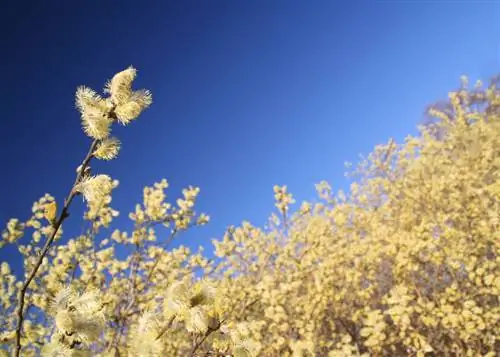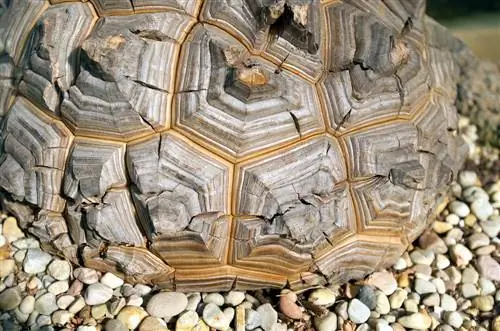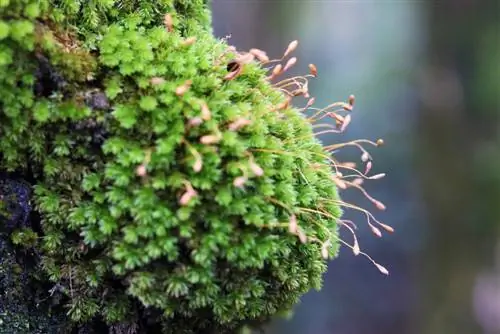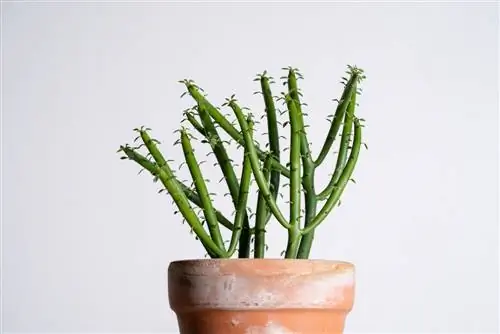- Author admin [email protected].
- Public 2023-12-16 16:46.
- Last modified 2025-01-23 11:22.
Read a commented profile of the turtle plant here with explanations of the bizarre growth. Tried-and-tested tips explain how you can easily propagate Dioscorea elephantipes, plant it skillfully and care for it properly.
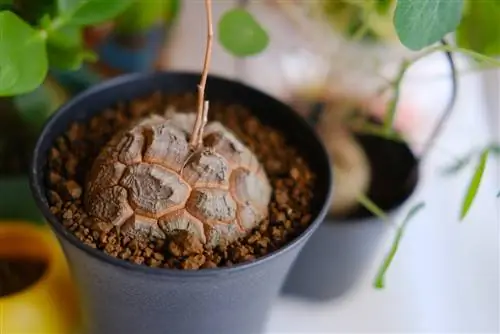
What is the turtle plant and how to care for it?
The turtle plant (Dioscorea elephantipes) is an exotic houseplant from South Africa that impresses with its striking, rounded, thickened caudex and twining tendrils with heart-shaped leaves. Easy to care for and long-lasting, it thrives in full sun to shaded locations and requires regular watering and fertilization during growth phases.
Profile
- Scientific name: Dioscorea elephantipes
- Family: Yam family (Dioscoreaceae)
- Synonym: elephant foot
- Origin: South Africa
- Growth type: climbing plant with caudex
- Growth height: 3 m to 5 m
- Leaf: heart-shaped
- Flower: panicle
- Fruit: Capsule
- Roots: Rhizomes
- Winter hardiness: not hardy
- Use: Houseplant
Growth
The South African turtle plant (Dioscorea elephantipes) is probably the most striking and interesting plant species within the yam family (Dioscoreaceae). Its German name is an apt allusion to the rounded, thickened shoot axis, whose surface structure is reminiscent of a turtle shell. Fast-growing, herbaceous climbing tendrils sprout from the slow-growing caudex. These unique growth characteristics make the exotic houseplant unmistakable:
- Growth type: herbaceous climbing plant with a semi-aerial, woody-cracked storage organ.
- Growth form: deciduous, twining/climbing with trellis, creeping (without trellis).
- Growth height: herbaceous plant parts 3 m to 5 m.
- Stem/shoot axis: rounded, thickened caudex with a diameter of 30 cm to 50 cm, rarely up to 100 cm in diameter.
- Special feature: variable growth and rest periods, regardless of the season.
- Gardenically interesting properties: easy to care for, sensitive to frost, tolerates cutting, slightly toxic, easy to propagate, bizarre, long-lasting.
Video: Young turtle plant viewed up close
Leaf
The caudex of a turtle plant sprouts twining tendrils adorned with these decorative leaves:
- Leaf shape: stalked, heart-shaped, weakly pronounced leaf veins.
- Leaf color: shiny green, yellowing before the dormant phase.
- Arrangement: alternate
Bloom
The turtle plant thrives as a dioecious species with separate sexes. Male and female flowers are on separate individuals. When it comes to cultivation as a houseplant, the flower ecology aspect is of secondary importance. Dioscorea elephantipes rarely blooms far from its African home regions. At a very advanced age and under ideal conditions, flowers develop with these characteristics:
- Inflorescence: hanging panicle with individual flowers.
- Single flower: short-stemmed, star-shaped.
- Flower color: yellow
Excursus
What does “variable growth and rest periods” mean?
The biological clock of a Dioscorea elephantipes ticks differently than hobby gardeners are used to with classic potted plants. Unlike cacti and other succulent houseplants, a turtle plant does not have a firmly cemented schedule for growth and rest. Sometimes the bizarre beauty grows from autumn to spring and rests in summer or vice versa. The intervals between the individual phases can be a few days or several months.
Planting turtle plant
Turtle plants are occasionally available to buy in specialist stores for succulents, cacti and tropical plants. Prices start at 7.90 euros for a 2 cm small caudex and reach 500 to 850 euros for a 50 cm caudex. Hobby gardeners buy seeds for an economical 3.50 euros and propagate the African elephant foot by sowing them. Read these tips about successful propagation, correct location selection and expert planting technology:
Propagation by sowing
A turtle plant is easy to propagate by sowing seeds. The following overview lists all the important framework conditions:
| Sowing | Key data |
|---|---|
| Time slot | all year round, preferably in spring |
| Sowing substrate | Cactus soil and sand (1:1) |
| Sowing depth | 0 to 0.5 cm (light germination) |
| Location | bright, without blazing sun |
| germination temperature | 22° to 25° Celsius |
| Germination time | 1 to 3 months |
| Continuing cultivation after germination | bright, 15° to 18° Celsius |
| Sowing care | keep slightly moist, do not fertilize |
Location
The ideal light and temperature conditions at the location are closely related to the current status of a turtle plant.
- Growth phase: full sun to partial sun, warm, protected from wind and rain at 20° to 25° Celsius.
- Rest phase: shady and cool at 10° to 15° Celsius.
- Temperature minimum: briefly 5° Celsius, permanently 10° Celsius.
Planting Tips
The correct planting of a Dioscorea elephantipes depends on the substrate quality and planting depth. Other criteria include the right pot size and precautions against waterlogging. A look at these planting tips provided useful insights:
- A permeable mineral mixture of cactus soil, sand and expanded clay is suitable as a substrate.
- A finger-thick drainage made of expanded clay on the bottom of the pot prevents waterlogging.
- The correct pot size is twice the diameter of the caudex.
- The planting depth is correct when the caudex extends above the soil surface by half to two thirds.
- A suitable climbing aid is available for the herbaceous tendrils, such as a bamboo trellis or wooden trellis.
Care for turtle plant
The variable growth and rest periods have a significant influence on the care of a turtle plant. When and how you water, fertilize, cut and overwinter a Dioscorea elephantipes depends on whether the plant is currently growing or dormant. The following care tips shed light on the darkness:
Care during the growth phase
The beginning of a growth phase can be easily recognized by the emergence of tendrils and leaves. Now care is picking up speed with these measures:
- Unpot the turtle plant, cut off dried roots and repot in fresh succulent soil.
- Water regularly with filtered rainwater or decalcified tap water.
- Allow the substrate to dry between waterings.
- Please note: Dryness of the ball triggers a premature rest phase. Waterlogging causes the caudex to rot.
- Add a liquid fertilizer for succulents to the watering water six to eight weeks after planting or repotting.
Care during the rest phase
The turtle plant announces that it is entering its dormant period when the herbaceous parts of the plant turn yellow. During the transition to dormant growth, please gradually reduce the watering. At the same time, the roots (€15.00 on Amazon) also die in the ground. Please give the morbid fading a free hand, as valuable nutrients are relocated to the caudex. In the end, the process results in this care:
- Change location to a shady to semi-shady location with 10° Celsius.
- Cut off dried vines and leaves.
- Watere very sparingly without letting the caudex dry out.
- Do not fertilize.
Diseases and pests
Regardless of the growth and rest phase, diseases, pests or care errors can cause headaches. The following overview draws attention to common malfunctions, names the causes and gives tips for effective countermeasures:
| malicious image | Cause | Immediate measure | Antidote |
|---|---|---|---|
| Mealy leaf coating | Powdery mildew | cut off affected plant parts | spray with whole milk-water solution (1:8) |
| Pests on undersides of leaves, curled leaf edges, sticky coating | Aphids | rinse herbaceous plant parts | spray with curd soap and spirit solution |
| Shriveled Caudex | Drought stress | diving in lime-free water | water more often |
| Soft caudex, bad smell | Waterlogging | repotting | water more economically |
Popular varieties
There are no known varieties of the turtle plant (Dioscorea elephantipes).
FAQ
Can a turtle plant overwinter in a partially shaded location?
Overwintering in a partially shaded location is possible if a turtle plant is currently in its dormant phase. Under this condition, a Dioscorea elephantipes tolerates temperatures of around 15° Celsius without exhausting itself by sprouting weak horny shoots. However, if the African succulent is in its growth phase, a sunny location and temperatures around 20° Celsius are mandatory.
Is the turtle plant poisonous?
The turtle plant is classified by botanists as slightly poisonous. Like all yam plants, the caudex of a Dioscorea elephantipes also contains toxic substances, such as the saponin diosgenin and the glycoside amygdalin. After consumption, the latter turns into hydrogen cyanide in the intestines. In a family household, a location out of the reach of children and pets is therefore recommended.
Is a Dioscorea elephantipes hardy?
No, a Dioscorea elephantipes is not hardy. The succulent plant from the yam family is native to the subtropical climate of South Africa. A turtle plant cannot survive temperatures below freezing. The short-term minimum temperature is 5° Celsius.
Can the turtle plant oversummer on the balcony?
If day and night temperatures exceed 10 degrees Celsius, you can clear out a turtle plant. The correct location on the balcony depends on the current floral condition. If the plant is in its growth phase, a warm, full sun location is ideal. If the fissured caudex stands without shoots or leaves, a shady, cool location is advantageous for the duration of the dormant phase.


